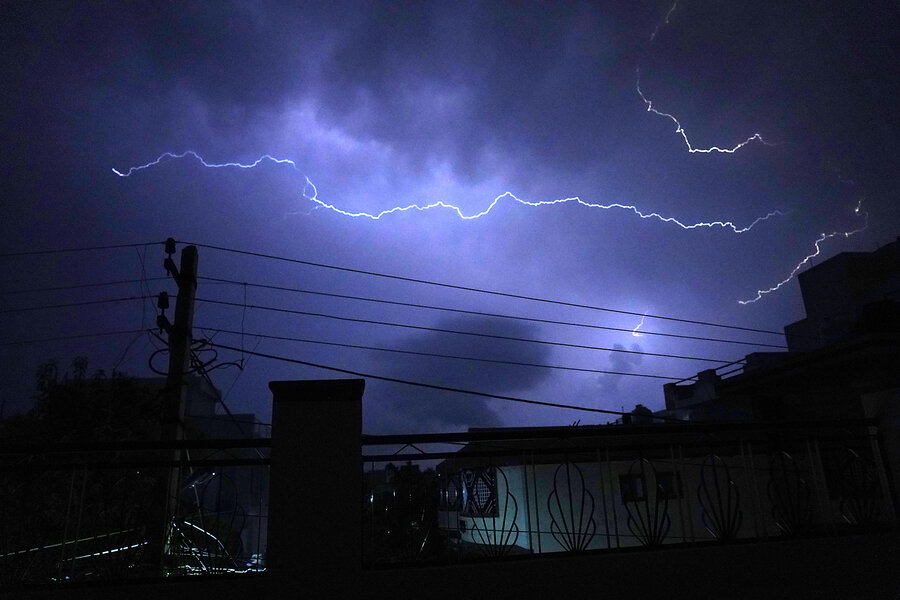In India, what wreaks more havoc than floods and heat? Lightning.
Loading...
| Delhi
Lightning claims roughly 3,000 lives every year in India, more than any other weather event. Activists and scientists have been sounding the alarm over this oft-ignored hazard, which is expected to increase due to climate change, but sustained progress has proved challenging.
India’s Meteorological Department only began forecasting lightning in 2019. And federal agencies still don’t classify it the same as earthquakes, cyclones, and other natural disasters, limiting funds for mitigation. Though early warning systems are now in place, lightning alerts often don’t reach the most vulnerable people in time. When they do, many don’t know how to protect themselves.
Why We Wrote This
A story focused onIndia is often at the front lines of climate change, but one of the largest natural threats to public safety gets the least attention. Why is progress on lightning safety so slow?
The good news is that injuries and deaths from lightning are almost always avoidable. Hundreds can be saved by getting across a simple message: Avoid trees during storms.
Spreading that message the last mile can involve low-tech solutions such as scribbling lightning warnings on blackboards in village squares or making sure safety information is available in local languages. Lightning safety activist Sanjay Srivastava says the government must also involve village councils in disaster management.
“The biggest challenge is lack of public awareness,” he says.
Individual districts show change is possible. With the help of a door-to-door awareness campaign, the city of Balasore in Odisha state was able to reduce annual deaths from about 35 to three.
In a small village in Jharkhand, India, 36 children were playing cricket when the skies turned gray and thunder rolled. Eight scrambled into a nearby culvert, and the rest took refuge under a tree. That tree was struck by lightning in minutes.
Many survived that night, but three of the children and their teacher joined the 2,641 Indians killed by lightning in 2015. To this day, lightning claims roughly 3,000 lives every year in India – more than any other weather event.
Activists and scientists throughout India have been sounding the alarm over this oft-ignored hazard, but sustained progress has proved challenging.
Why We Wrote This
A story focused onIndia is often at the front lines of climate change, but one of the largest natural threats to public safety gets the least attention. Why is progress on lightning safety so slow?
Though early warning systems are now in place, lightning alerts often don’t reach the most vulnerable people in time. When they do, many don’t know how to protect themselves – the majority of lightning victims die under trees, like those in Jharkhand. Another problem is that the government’s attitude toward lightning is reactive rather than proactive, says Manoranjan Mishra, a lightning researcher and professor at Fakir Mohan University in Odisha state. Instead of bolstering protection systems, funds are utilized after the fact, to compensate victims’ families.
These shortfalls stem in part from the sporadic nature of lightning, which only makes headlines when there’s a mass casualty. But as lightning activity rises with climate change, mitigation efforts are more critical than ever. “We have to adapt to it, or we will die,” says Dr. Mishra.
What is lost to lightning
Lightning safety activist Sanjay Srivastava was among those who rushed to the site of the 2015 Jharkhand strike. The teacher’s death hit him hard. The man was the breadwinner of his family, the local school’s only teacher, and a dedicated social worker. “I cannot forget his face,” Mr. Srivastava says.
Mr. Srivastava was a colonel in the technical arm of the Indian army, where he worked on lightning protection of strategic locations such as atomic power plants, before returning to his native Jharkhand in 2008 to work as a disaster management expert. At that time, there were no early warning or lightning safety systems in place.
“The very first day when I went, there were 37 deaths [in the area] due to lightning,” he recalls.
Since then, he’s been on a mission to teach people how to stay safe during storms, and to jolt authorities into action. He’s the convener of the Lightning Resilient India Campaign, an initiative started in 2019 by the nonprofit Climate Resilient Observing Systems Promotion Council and the Indian Meteorological Department. Its aim: prevent the loss of lives and livelihood due to lightning.
With the help of volunteers and nonprofits, Mr. Srivastava has conducted lightning safety demonstrations in some of the most remote pockets of the country, but he acknowledges that progress has been inconsistent.
“Everybody is doing piecemeal work,” he says.
India’s Meteorological Department only began forecasting lightning in 2019. And federal agencies still don’t classify it the same as earthquakes, cyclones, and other natural disasters, limiting funds for mitigation.
In 2018, the Indian Institute of Tropical Meteorology, based in Pune, launched an app called Damini that uses IITM’s own sensor network to predict lightning activity and issues alerts to people in a 12-to-25-mile radius an hour or so before the onset of lightning. But the farmer in the field or the cattle herder on the hill may not have a smartphone and is often oblivious to these warnings.
In 2022, lightning claimed 2,887 lives, 35.8% of all deaths due to the forces of nature. The vast majority of fatalities occurred in rural areas, to farmers working outside. Experts believe 2023 figures will be similar.
For those who survive lightning strikes, the fernlike scars can carry intense stigma.
“If it comes to a girl of marriageable age, it becomes a social trauma,” says Mr. Srivastava, noting how there’s a common myth that lightning is a way of cursing sinners. “The biggest challenge is lack of public awareness.”
A way forward
The good news is that injuries and deaths from lightning are almost always avoidable. Hundreds can be saved by getting across a simple message: Avoid trees during storms. But India must work on spreading that message the last mile, says Dr. Mishra. This can involve low-tech solutions such as scribbling lightning warnings on blackboards in village squares or making sure safety information is available in local languages, he says.
In communicating warnings and safety advice to the most at-risk rural populations, a crucial link is the village council, says Mr. Srivastava. He argues that the government must involve these small but important bodies in disaster management, and advocates for lightning-safe shelters in every community. Currently, their numbers are negligible, he says.
Others are working to improve warning systems. Scientists such as IITM’s Sunil Pawar are trying to use artificial intelligence to accurately predict lightning at a micro level – a cluster of villages, for instance – and at least three hours in advance, so officials have time to act.
More localized research is also needed to understand the myriad of factors leading to deaths, says Dr. Pawar. His state of Maharashtra doesn’t see high lightning activity but still registers many lightning-related deaths, partly because lightning tends to occur there during the afternoon, when people are usually outdoors.
While the nationwide death toll hasn’t budged, individual districts show change is possible. With the help of a door-to-door awareness campaign, Odisha’s Balasore was able to reduce annual deaths from about 35 to three. Knowing palm trees can act as natural conductors to absorb lightning flashes, Odisha has also begun a massive plantation drive.
Overall, Dr. Pawar feels encouraged by the growing interest in lightning safety. A few decades ago, nobody seemed to understand how deadly lightning was. Now he gets a call nearly every day from some state government asking what it can do.










